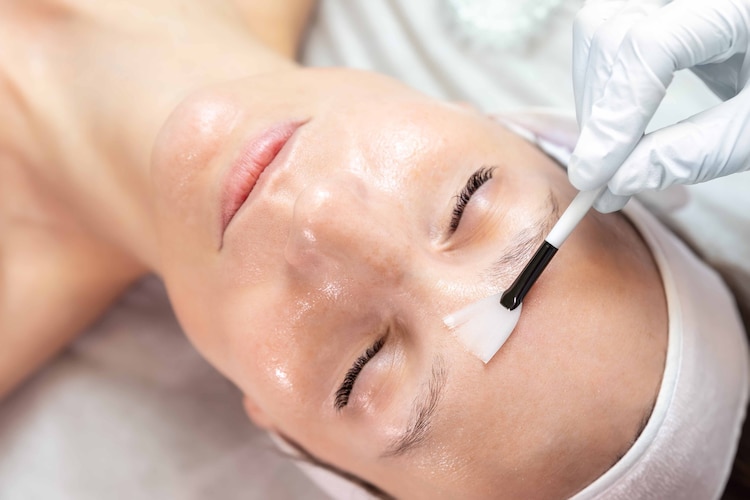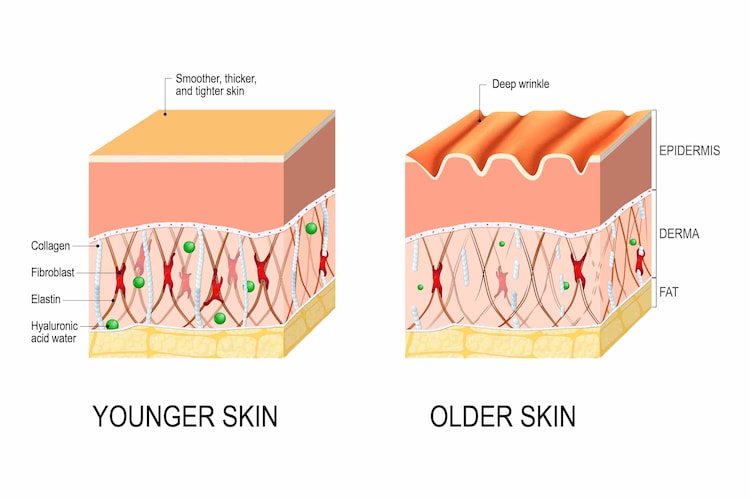Can chemical peels like phenol peels cure your skin problems?
During a chemical peel, the skin is treated with a chemical solution that damages or traumatizes its layers, causing them to peel off.
In short
- Chemical peels are gaining prominence in the beauty industry
- Experts believe chemical peels are effective for certain skin types
- However, they also have several side effects
Getting clear, glass-like skin takes effort. If your goal is to get clear skin, you may have to take a variety of paths, from maintaining a regular skincare routine to eating clean. However, this journey to getting clear skin often comes with problems like acne, acne scars, wrinkles, etc.
Recently, a new way to get clear skin has been making the rounds in the beauty market, where the process to get it is similar to the shapeshifters from ‘The Boys’. If you don’t know what we are talking about, then let us tell you that shapeshifters can get new skin by peeling off their skin.
Now, we admit this example was an exaggeration, but peeling off the top layer of skin to get clear skin is actually a thing, FatherBeauty enthusiasts are getting this done and it is called chemical peel.
from ancient egypt
Chemical peels are nothing new.
It is believed that in ancient Egypt, Cleopatra bathed in sour milk (which contains lactic acid) to improve her skin.

However, modern-day chemical peeling techniques have become refined and more widespread thanks to dermatologists like Dr. George Miller McKee, who has been instrumental in developing and popularizing these treatments in the 21st century.
Today, thanks to social media and thousands of accounts of clinics and doctors who promote beauty treatments like chemical peels using Instagram Reels or YouTube Shorts, they are garnering more attention than ever.
What is this?
“During chemical exfoliation, the skin is treated with a chemical solution that damages or traumatizes the layers of the skin. Eventually, the layers of skin peel off, revealing younger-looking skin. The rejuvenated skin usually has a smoother skin tone with an even complexion, brighter complexion and fewer wrinkles,” explains Dr Avinash Jadhav, dermatologist, cosmetologist and hair transplant surgeon at Ruby Hall Clinic, Delhi.

According to Dr Geetika Sanodia Biyani, Consultant Dermatologist and Trichologist at Dr LH Hiranandani Hospital, Powai, Mumbai, there are three types of chemical peels and each is more intense than the other.
- The first method is a light peel, which uses mild acids like alpha-hydroxy acids (AHAs).
- The second is called medium depth and uses acids such as trichloroacetic acid (TCA) or low concentration phenol.
- Finally, we have deep peels where higher concentrations of phenol and other similar acids are used.
“Chemical peels can be used to treat certain skin conditions or to enhance your skin tone and texture, thereby improving your beauty,” says Dr. Jadhav.
P.S.: Higher the intensity, more days it will take for your skin to recover.
how do they work?
To understand the mechanism behind chemical peels, you need to understand that our skin has three layers, the epidermis, dermis, and hypodermis, and chemical peels work only on the epidermis (The topmost layer) of your skin.
Dr. Ibrahim Yahya, Consultant Dermatologist, Sinusoderma, Chennai, explains india today The first step during a chemical peel is for a dermatologist to select an exfoliating solution with an acidic pH level to remove the top layer of damaged and scarred skin (the epidermis).
“The acidic strength and choice of solution may vary depending on the skin condition and indication for treatment,” says Dr. Yahya.
The exfoliating nature of the acid helps it penetrate the skin and remove dead skin cells by loosening the bonds between them.

This results in controlled damage to the skin followed by the release of certain inflammatory mediators and cytokines, leading to deposition of collagen, regeneration of elastin, thickening of the epidermis and improvement in skin volume.
Eventually, the new skin layer that emerges over the next few days has a better texture, is smoother, and blemish-free.
Phenol Peels: Viral
According to Dr Biyani, of the three types, phenol peels are becoming quite popular due to their “intensive effects.”
She says phenol peels work great for treating severe wrinkles, sun damage, scars, and dark spots because they remove multiple layers of damaged skin and encourage the growth of fresh, healthy skin in its place.
View this post on InstagramA post shared by Anthony Youn, MD, FACS (@tonyyounmd)
It’s also worth noting that phenol peels are the most concentrated, and they come with a lot of side effects and risks, especially for extremely sensitive skin (We’ll discuss this more in a bit).
Are chemical peels effective?
india today I spoke to several experts and almost all of them said that chemical peels are effective for some people and can show dramatic results, but they also come with a number of side effects.
For instance, according to Dr Shaurya Thakran, founder of Delhi-based Raksha Aesthetics, the viral phenol peel “has some serious side effects” because of the high acidity of the chemicals used in it.
“People with darker skin may have permanent lightening (hypopigmentation), which can look unpleasant and unnatural. We [dermatologists] “People with certain medical conditions need to be extra cautious, as phenol can be absorbed directly into the skin, affecting internal organs, such as the heart and kidneys,” he added.
Furthermore, she adds that the post-treatment skin care regimen is very important, as if not followed it can lead to recurrent microbial infections, redness and inflammation of the skin that can last for months.
Side effects of chemical peels
According to experts, not only phenol peels, but chemical peels also have some side effects. Dr. Shaurya says that peels using carbolic acid rarely cause damage to organs like kidneys and heart.
Dr Yahya added that chemical peels can also have their disadvantages, depending on the type and concentration of the acid.
He said its side effects include redness, swelling and pain that can last from a few days to several weeks.
“The treated skin becomes lighter than the surrounding skin,” he said.
Dr Shaurya also warns that if the peel reaches the deeper layers of our skin, it may leave permanent scars.
“This skin rejuvenation process [after the peel]While it may seem easy, it is not and requires extra precautionary measures. If there is a lack of skincare after the procedure, there may be some signs of permanent damage to the skin,” she adds.
Dr. Jadav also advises that you should not undergo chemical peel treatment if:
- Laying background of abnormal skin markings.
- Your scars will have more color.
- Have a skin disorder or take medications that make your skin more sensitive.
- Unable to avoid light during the healing phase.
Another major disadvantage of chemical peels is that they can be heavy on your pocket, as a single session can cost anywhere between Rs 20,000 to Rs 50,000. (You may need multiple sessions to see effective results),
At the end
The severity of side effects depends on the depth and strength of the peel your doctor uses on you, so it is important that you consult a dermatologist (experienced) before you decide which peel is suitable for your skin type, and what condition you want to address.







